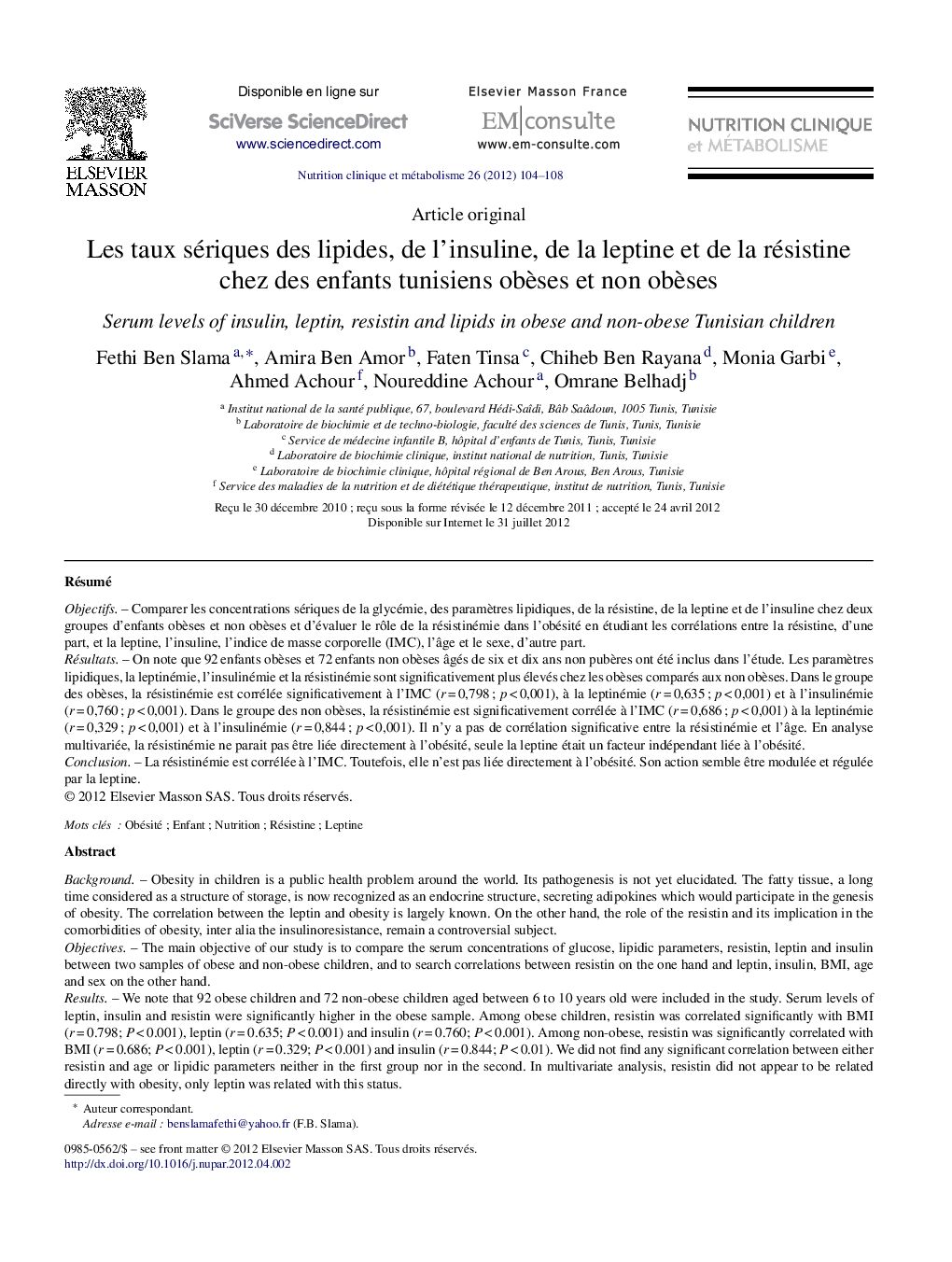| Article ID | Journal | Published Year | Pages | File Type |
|---|---|---|---|---|
| 2692057 | Nutrition Clinique et Métabolisme | 2012 | 5 Pages |
RésuméObjectifsComparer les concentrations sériques de la glycémie, des paramètres lipidiques, de la résistine, de la leptine et de l’insuline chez deux groupes d’enfants obèses et non obèses et d’évaluer le rôle de la résistinémie dans l’obésité en étudiant les corrélations entre la résistine, d’une part, et la leptine, l’insuline, l’indice de masse corporelle (IMC), l’âge et le sexe, d’autre part.RésultatsOn note que 92 enfants obèses et 72 enfants non obèses âgés de six et dix ans non pubères ont été inclus dans l’étude. Les paramètres lipidiques, la leptinémie, l’insulinémie et la résistinémie sont significativement plus élevés chez les obèses comparés aux non obèses. Dans le groupe des obèses, la résistinémie est corrélée significativement à l’IMC (r = 0,798 ; p < 0,001), à la leptinémie (r = 0,635 ; p < 0,001) et à l’insulinémie (r = 0,760 ; p < 0,001). Dans le groupe des non obèses, la résistinémie est significativement corrélée à l’IMC (r = 0,686 ; p < 0,001) à la leptinémie (r = 0,329 ; p < 0,001) et à l’insulinémie (r = 0,844 ; p < 0,001). Il n’y a pas de corrélation significative entre la résistinémie et l’âge. En analyse multivariée, la résistinémie ne parait pas être liée directement à l’obésité, seule la leptine était un facteur indépendant liée à l’obésité.ConclusionLa résistinémie est corrélée à l’IMC. Toutefois, elle n’est pas liée directement à l’obésité. Son action semble être modulée et régulée par la leptine.
BackgroundObesity in children is a public health problem around the world. Its pathogenesis is not yet elucidated. The fatty tissue, a long time considered as a structure of storage, is now recognized as an endocrine structure, secreting adipokines which would participate in the genesis of obesity. The correlation between the leptin and obesity is largely known. On the other hand, the role of the resistin and its implication in the comorbidities of obesity, inter alia the insulinoresistance, remain a controversial subject.ObjectivesThe main objective of our study is to compare the serum concentrations of glucose, lipidic parameters, resistin, leptin and insulin between two samples of obese and non-obese children, and to search correlations between resistin on the one hand and leptin, insulin, BMI, age and sex on the other hand.ResultsWe note that 92 obese children and 72 non-obese children aged between 6 to 10 years old were included in the study. Serum levels of leptin, insulin and resistin were significantly higher in the obese sample. Among obese children, resistin was correlated significantly with BMI (r = 0.798; P < 0.001), leptin (r = 0.635; P < 0.001) and insulin (r = 0.760; P < 0.001). Among non-obese, resistin was significantly correlated with BMI (r = 0.686; P < 0.001), leptin (r = 0.329; P < 0.001) and insulin (r = 0.844; P < 0.01). We did not find any significant correlation between either resistin and age or lipidic parameters neither in the first group nor in the second. In multivariate analysis, resistin did not appear to be related directly with obesity, only leptin was related with this status.ConclusionOur results prove that resistin is correlated with BMI. However, it is not related directly to obesity. Its action seems to be modulated and controlled by leptin.
